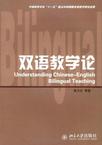双语教学论
出版时间:2009-12 出版社:北京大学出版社 作者:欧卫红 页数:319 字数:363000
Tag标签:无
前言
随着全球化进程的加速、国际竞争的加剧,各国对国际化双语或多语人才的需求日益迫切。 但是,外语教学效率低下,培养出的学生不能熟练运用外语,是各国普遍面临的巨大挑战。为此,从20世纪90年代以来,许多国家和地区,在检讨已有的外语教育政策和实践的基础上,采取多种改革措施提高公民外语水平。其中,以外语作为教学语言学习非语言学科以增加学生接触外语和使用外语时空的双语教育理念,尤为国际教育研究界所关注,并成为许多国家课程改革和外语教育改革的重要内容。 这表明,人类语言教学已进入“母语教学+外语教学+双语教学”的大语言教学时代。 在这样的大背景下,中国中小学汉英双语教学实验异军突起,发展迅猛。双语教学实验的初步成果为人们带来了希冀。这正是:“众里寻他千百度,蓦然回首,那人却在,灯火阑珊处。” 双语教学是素质教育新的切入点:语言学习与学科学习相辅相成;双语思维能力促进智慧的提升;跨文化交际能力拓宽学生视野;学术语言能力为高校学习奠基;双语教学促进学科教师的发展:双语教育推动学校的整体发展。因此,中小学双语教学实验深受社会各界的关注与支持。 教育部2001年4号文件《关于加强高等学校本科教学工作提高教学质量的若干意见》要求本科教育逐步使用英语等外语进行公共课和专业课教学,特别是高新领域的生物技术、信息技术等专业,以及为适应我国加入WTO后需要的金融、法律等专业。高校开展的双语教学实验在很大程度上推动了中小学双语教学实验的发展。 目前,我国中小学双语教学实验已初具规模,呈现出教育规划区域性实验与课题研究布点实验并驾齐驱的发展态势。我国经济发达地区特别是沿海地区双语教学实验发展较快。上海、苏州、无锡,辽宁的双语教学实验已列入当地的教育发展规划。广州、天津、青岛、深圳和成都双语教学实验稳步发展,成绩显著。桂林、重庆、北京、哈尔滨等城市和中西部的一些学校在进行着多种教学模式的实验和尝试。
内容概要
本书共5章,除第4章外,其余各章部以英汉两种语言陈述,英语为丰,汉语为辅,英语部分臼成体系,汉语部分是前者的要点呈现。 Chapter 1 Basic Theories语言学基本理论本章所涉及的主要是语言学关于语言教学和语言学习的基本理论,从第一语言习得和学习,到第二语言学习和习得,再到双语的学习和习得。在这一部分,我们明确地提出:对双语的学习和习得也存在“关键期”的假说,这一假说是双语教学应从基础教育阶段开始实施的观点的重要理论支撑。 Chapter 2 Teaching Methodology教学法本章首先讨论了英语教学法和学科(如数学、科学、音乐等)教学法,在此基础上提出双语教学法这一概念。我们认为:英语教学法和学科教学法是双语教学法的基础,双语教学法足前两者的融合、拓展和深化,是双语教师应达到的较高境界、应具备的特殊能力。本章只涉及了小学阶段数学、科学和音乐三个学科。 Chapter 3 Grammar语法要点语法是双语教师的基本功,但本章不是对语法知识的全面陈述,而只是为双语课堂教学所需而浓缩的一些要点,主要供非英语专业的双语教师参考、查阅。同时,也简议了一些热点问题,特别是在双语教学中的热点问题,如双语数学加法运算教学中主谓一致等。 Chapter 4 Resources教学资源本章资源包括4.1学科术语、表达法和4.2教案分析两部分。第一部分根据数学、科学和音乐三门学科中小学,特别是小学阶段中文课本的主要内容研编而成,为双语教师在备课、上课、教研时查阅、应用提供参考:第二部分教案分析,是对网上随机选定的教案样本进行的分析。但我们的分析十分肤浅,且可能失之偏颇,仅供参考。 Chapter 5 Teacher Development教师发展有其自身的内涵、作用、途径等。本章主要从双语教学的角度,谈双语教师职前职后的专业发展。
书籍目录
Chapter One Basic Theories 1.1 Theories of first language acquisition and learning 1.1.1 Language acquisition and language learning 1.1.2 Theories of first language acquisition. 1.1.3 Language acquisition view of cognitive linguistics 1.1.4 Language development. 1.1.5 The critical period hypothesis 1.2 Theories of second language learning and acquisition. 1.2.1 Critical period of second language learning and acquisition 1.2.2 Theories of second language acquisition 1.2.3 Practical pedagogical implications of SLA research 1.2.4 Individual learner differences and second language acquisition 1.2.5 Interlanguage 1.3 Theories of bilingual learning and acquisition 1.3.1 Appellation 1.3.2 Definitions 1.3.3 Types of bilingual teaching models 1.3.4 Bilingual education examples across the world 1.3.5 Chinese-English bilingual teaching in China 1.3.6 The critical period hypothesis of bilingual teaching Chapter Two Teaching Methodology. 2.1 Main ideas about English teaching methodology 2.1.1 Language and language teaching 2.1.2 The New National English Curriculum 2.1.3 Current English teaching methodology 2.1.4 Lesson planning 2.1.5 Classroom management 2.1.6 Assessment in language teaching 2.1.7 Classroom English 2.2 Main ideas about subject methodology 2.2.1 Main ideas about math teaching methodology 2.2.2 Main ideas about science teaching methodology 2.2.3 Main ideas about music teaching methodology 2.3 Main ideas about bilingual teaching methodology 2.3.1 Teaching goals 2.3.2 Teaching models and strategies 2.3.3 Code-switching 2.3.4 Bilingual teaching methodology in some subjects Reference books Chapter Three Grammatical Points for Bilingual Teaching 3.1 Verb and tense 3.1.1 Main verbs 3.1.2 Auxiliaries 3.1.3 Tenses 3.2 Subject-Verb concord 3.2.1 Brief introduction about concord 3.2.2 The common rule of agreement 3.3 Participle 3.4 Commonly used sentence pattems 3.4.1 Existential sentence pattern 3.4.2 It-patterns 3.4.3 Conditional sentences 3.5 Simple sentence 3.5.1 Positive and negative statements 3.5.2 Questions 3.5.3 Commands 3.5.4 Exclamations 3.6 Clause 3.6.1 Clause element 3.6.2 Basic clause types 3.7 Degree and construction 3.7.1 Degree of adjectives and adverbs 3.7.2 Typical comparative structures 3.8 Direct and indirect speech 3.9 Infinitive 3.10 Passive voice 3.11 Some issues Reference books Chapter Four Resources for Bilingual Classroom Teaching Chapter Five Teacher Development Glossary and Index
章节摘录
Language is the most important tool for human communication, and thinking, and it is the vehicle by which knowledge is transmitted. The use of language is an extraordinarily complicated skill. Each of us has the capacity to produce and understand an almost limitless number of sentences. For many people this skill for using language is "a defining feature of humanity" (Lund 2003: 39). Yet this complicated skill seems to be learned by children with ease and nearly all children who are exposed to language learn it rapidly. How this remarkable development take place and how children so quickly and as if by magic acquire language have interested experts in a variety of areas, such as linguists, psychologists and psycholinguists. Over the past years, there have been a large number of differing theories about how children acquire their first language. Among them are the three leading positions: behaviorist, innatist, and interactional/ developmental perspectives. 1.1.1 Language acquisition and language learning Before the introduction to the theories of first language acquisition, let us have an understanding of the following terms: Language acquisition is a complicated process which involves a wide range of social, psychological, cognitive, linguistic and physiological factors.
图书封面
图书标签Tags
无
评论、评分、阅读与下载
用户评论 (总计0条)
相关图书
- 国际税收
- 服务品牌传播
- 财务报告分析
- 新闻摄影实务
- 教育社会学概论
- 英语时文泛读学习参考用书(第4册)
- 园区网互联及网站建设
- ABAQUS在隧道及地下工程中的应用
- 科学计算和C程序集
- Visual C++ 2008开发经验与技巧宝典
- C++编程关键路径
- 网络化控制系统故障诊断与容错控制
- 游戏动画像素图制作教程
- Java语言程序设计
- 游戏动画色彩基础教程
- Flash动画基础教程
- Access数据库技术及应用
- 计算机网络基础教程
- 计算机网络基础实训
- 计算机组成原理
- 计算机辅助设计
- Visual FoxPro程序设计
- 趣味C程序设计集锦
- Visual FoxPro程序设计实训与考试指导
- Ansoft HFSS磁场分析与应用实例
